(serves 3)
Every place has its own way to prepare Korma but its features are universal. The curry is always cooked using almonds and/or cashew nuts as its base flavour, it is always light couloured and it is always mild. This last characteristic makes Korma the go to curry for anyone who are not into spicy food, and children. The Singapore method uses evaporated milk instead of yogurt or coconut milk to marinate the meat and this creates a distinct texture and taste unique to this method of preparation.
 Ingredients
Ingredients
- Chicken Thighs (4, deboned)
- Shallots (4)
- Ginger (1 thumb)
- Evaporated Milk (100 ml)
- Coconut Milk (150 ml)
- Almond Flour
- Curry Powder
- Cumin
- Chicken Cube (1)
- Cashew Nuts (50g)
Preparation (4-6 hours ahead)
- Place the chicken into a bowl or plastic container and sprinkle in 2 heaped T of curry powder. Evenly coat each piece of chicken. Add 100 ml of evaporated milk, and mix well. Cover and leave in the fridge for a minimum of four hours.

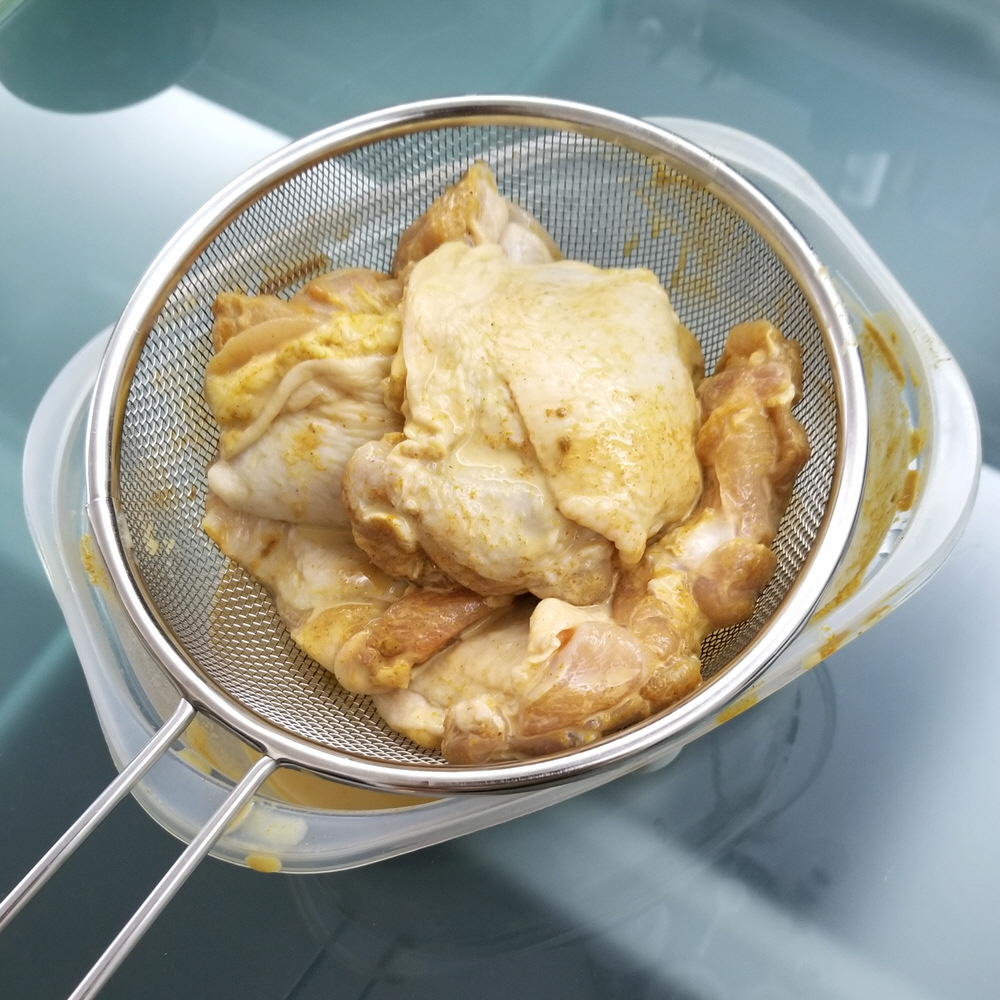
Preparation
- Peel and cut each shallot in half. Julienne the shallots.
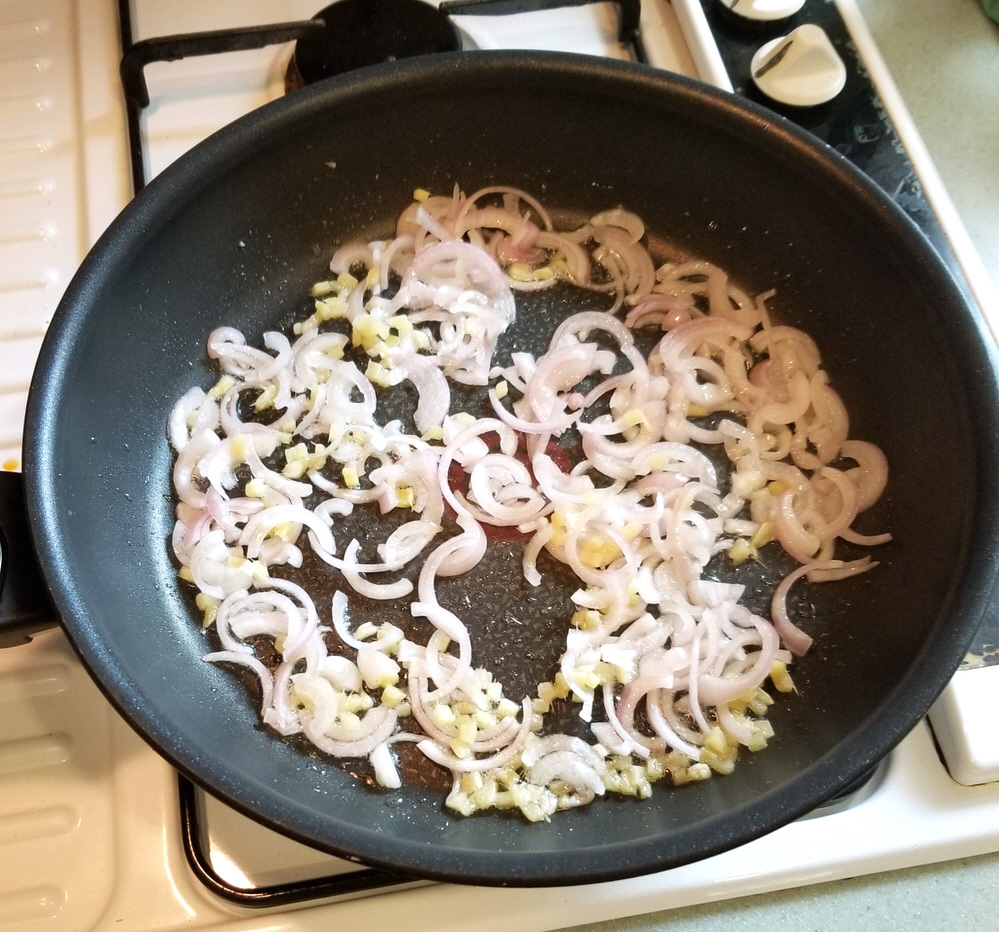
- Peel the ginger and cut first into slices 2mm thick. Next slice into strips and then finally cubes.
- Put 3T of oil in a large pan and add the sliced shallots and diced ginger. Pan fry until the shallots start to brown. Transfer the contents to a plate temporarily.
- Dissolve 1 chicken cube in 1 cup of water. Add the resulting chicken stock to the chicken and move the chicken about to wash off the marinade. Drain the chicken in a strainer over the container as shown above.
- Using the same pan, heat up 1 T of oil and pan fry the chicken. Start with a sizzling hot pan and fry the chicken skin side down for 2 minutes. Flip the chicken, turn the heat down and pan fry for a further 2 minutes.
- Transfer the chicken to a cutting board to cool.
- Pour the diluted marinade into the pan and return the shallots and ginger to the pan.

- Bring the pan to a simmer and sprinkle in 4T almond flour and 1T cumin. Stir until there are no clumps and leave on a simmer.
- By now the chicken should have cooled enough to touch. Cut each chicken thigh into about six pieces. Return the chicken together with any drippings back into the pan.
- Add 150 ml coconut milk, 50 g (1/4 cup) of roasted cashew nuts and 1t of sugar. Cover and simmer for an additional 10 minutes.
- Check if you wish to add salt before serving. Chop up 1 sprig of coriander and use it as a garnish.
Notes
- In case you are wondering what is curry powder,
 you can refer to the ingredients listed on the package of curry powder on the right. Curry powder is the base for making curries. It is not the same as Garam Masala, which is just a seasoning.
you can refer to the ingredients listed on the package of curry powder on the right. Curry powder is the base for making curries. It is not the same as Garam Masala, which is just a seasoning.
- If you’ll be making other dishes, you can prepare your korma ahead of time and just reheat to serve. It doesn’t taste any better if freshly made.
- The thicker parts of a chicken thigh will not be cooked from 4 minutes of pan frying, especially without a drop lid. That’s fine, simmering in the curry will finish the job. The idea is to caramelize the chicken and extract the oil and flavour from the skin.
- I find cutting the chicken using a pair of kitchen scissors easier than using a knife.
- Though its not part of the recipe, you should serve your korma with steamed rice or some kind of Indian bread.
Tags: Almonds, Cashews, Chicken, Coconut, Curry, Shallots
(serves 3 to 4)
Miso Stew or Miso Nabe is a winter dish that is popular in Hokkaido. The concentration of protein and carbohydrates in miso and soya milk creates a stew that is hearty and robust, giving it the power to keep the cold at bay. Every region has its own unique way of cooking their miso stew and there is no definitive cooking method or set of ingredients, though the meat is usually fish, pork or chicken. If you’ve never tired a Miso Stew don’t worry, my particular way of cooking Miso Stew is suitable to Western tastes.
Ingredients
- Chicken Legs (2, with thigh)
- Red Miso (4T)
- Carrot (1)
- Onion (1)
- Mushroom (1.5 cups)
- Yam (1)
- Garlic (1T, minced)
- Mirin
- Sake
- Soy Sauce
- Soya Milk (unsweetened, 3/4 Cup)
- Maple Syrup
Preparation (the day before)
- Debone the chicken and cut the meat into bite sized chunks. Keep the bones in the freezer for use the next day.
- Mix in a large bowl 2T Red Miso, 2T Sake, 1T Mirin and 1T Maple Syrup until you get a paste. Stir in 1T of minced garlic.
- Place the chicken meat in the bowl and toss well until each piece is coated with the marinade. Cover the bowl with cling film and keep it in the fridge overnight.
Preparation
- Peel a yam and cut it into bit sized chunks. Place the yam pieces on a sheet of aluminium foil and drizzle them with 2T oil and 2T mirin. Wrap the yam up in the foil and place in a toaster oven set at 180oC (360oF) for twenty five minutes.
- Put 3T of oil in a large pan (or clay pot) and heat the pan until the oil is searing hot. Keeping the fire on high, pour in the chicken together with all the marinade. Stir fry.
- When the chicken begins to shrink, add 3/4 cup of soy milk and 3/4 of water. After a quick stir, pick out the chicken pieces and set them aside on a plate.
- When the contents of the pan come to a boil again, put the chicken bones in the pan, as well as 1T sugar, 1T Soy Sauce and 2T of Red Miso. Turn the fire down to bring the liquid in the pan to a low simmer.
- Peel a carrot and slice it into 1/8 inch thick oval pieces. Put the carrot slices in the pan.
- Peel an onion and cut it into 6 equal wedges. Place the onion in the pan. Cover the pan and simmer for about 15 minutes.
- Cut your mushrooms into appropriate size if you have chosen to use a big variety. I used Shimeji in the picture above and used them whole.
- When the carrot is no longer crunchy, add the mushrooms, chicken and yam to the pan. Cover and simmer for a further five minutes. Remove the chicken bones before serving.
Notes
- You’ll notice I specified Red Miso above. You can also use Hatcho Miso, but preferable not any of the white, yellow or golden varieties of Miso, for the unique flavour of miso dissipates into plain saltiness with cooking. For more information on Miso, you can refer to this post about Miso.
- Nabe (pronounced nar-bay) is not the Japanese word for stew. It refers to a shared hot pot, sort of like a fondue using soup.
- If don’t have any unsweetened soya milk, you can use plain milk instead.
- The reason you put in the carrots before the onion is carrot takes longer to soften. Don’t reverse the order of steps 5 and 6.
- One key element of this recipe is cooking the yam and chicken separately from the stew. Both chicken and yam taste better when cooked at high temperatures. You can of course choose to just boil everything in the stew, but the result will not be as good.
- Miso stew is best eaten with steamed rice as a staple, although you can use another type of staple, like noodles or bread. This stew is not meant to be eaten on its own.
- Instead of putting the bones in the freezer, you could also keep them in the bowl with the marinated chicken if it is big enough. A third option would be to boil the bones to create 3/4 cup of stock which you then put in the fridge.
Tags: Carrots, Chicken, Japan, Mirin, Miso, Onion, Soya Milk
(serves 2-3)
This is a recipe for BBQ wings, the type you’d find in a sports bar. For years I tried to cook these wings at home in the same style with limited success. Then one day I discovered the secret to marinating chicken wings. Most recipes use the method of brushing the wings with sauce as you cook them, because its very difficult for flavours to penetrate chicken skin and reach the meat within, but this recipe doesn’t. The secret is counter-intuitive: you have to cook the wings before marinating them.
Ingredients 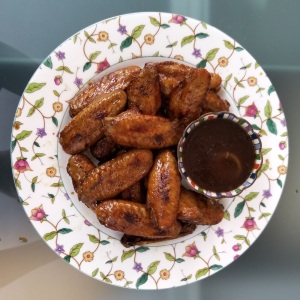
- Chicken Wings (20 mid joint, 700g)
- Shallots (4)
- Garlic (1 bulb)
- BBQ Sauce (1/3 cup)
- Cumin
- Mustard
- Liquid Smoke
- Whiskey
Preparation
- In a medium sized pot, mix 1/3 cup of BBQ sauce with 1.5 cups water, 1t mustard, 1t cumin and 1t salt.
- Peel the garlic and shallots and put them whole into the pot.
- Rinse your chicken wings and add them to the pot.
- Bring the pot to a boil. After 5 minutes of boiling, carefully fish out the chicken wings without damaging the skin. Put the wings in a Tupperware-like of container.
- Continue to simmer the sauce until it has halved in volume. This should take perhaps fifteen minutes. Turn off the heat and stir in 1t liquid smoke and 1T whiskey.
- After the sauce has cooled sufficiently, pour it into the container with the wings. Cover and leave the wings to marinate in the fridge overnight, or in any case for at least six hours. Shake once or twice to allow the marinade to reach between the wings.
- Preheat your toaster oven to 200oC (390oF) degrees.
- Arrange the wings on a wire rack in the toaster oven tray and bake for 25 minutes. You’ll need to do this in two batches as the wings should not touch each other.
- Warm up the leftover marinade in the microwave or in a saucepan. You can serve the wings either with the BBQ sauce separate or coated with the BBQ sauce.
Notes 
- The most important thing you can do is cover your toaster oven tray with foil, so you don’t have to wash off the carbonized BBQ sauce.
- Do not boil the wings for more than 5 minutes. You want the wings to be cooked, but not the skin to soften too much.
- If you are cooking the wings in a full sized oven, it will probably take less than 25 minutes. They are done when you notice dark splotches develop. You can of course also simply cook the wings over a actual BBQ.
- The same method works for all kinds of sauces you might want to flavour wings with, like teriyaki or oyster sauce. Just boil for five minutes and marinate overnight in the fridge.
Tags: BBQ, Chicken, Cumin, Mustard, Toaster Oven
(serves 4-5)
I just made this duck salad on Christmas eve and it is one of my favourite appetizers for the festive season; it’s got just the right amount of red, and green. Duck breast is surprisingly easy to prepare once you know the essential steps, perhaps easier than chicken breast even. Another thing I like about this recipe is the use of cranberry. We are used to having orange or red wine as the primary flavour that goes with duck and cranberry makes for a refreshing change. It is also a great ingredient for a salad dressing.
Ingredients 
- Duck Breasts (2, frozen)
- Baby Spinach (150g)
- Leek (1 cup, chopped)
- Cranberry Sauce
- Marmalade
- Mustard
- Balsamic Vinegar
- Liquid Smoke
- Salt
- Brown Sugar (soft)
- Brown Mushrooms (10)
- Cherry Tomatoes (10)
Preparation
- Defrost the duck breasts and brine in a solution of of 4 cups of water, 3T salt, 1T muscovado sugar for about 4 hours.
- After rinsing the duck breasts, Rub them with 2t of liquid smoke.
- Julienne the white portion of a stalk of leek until you have 1 cup.
- Using a sharp knife, scour the duck skin as shown. Do not cut all the way through the fat; if you can see the meat below, it’s too deep. Also, you should space the cuts in accordance with how you intend to slice the duck later. Here I’ve made my cuts two slices
 apart.
apart.
- Heat up a pan with a dash of oil and on low heat pan fry the duck breasts for 2 minutes. Only pan fry with the skin side down and move the breasts occasionally to make sure they don’t stick to the pan. The purpose here is to render as much duck fat as you can from the skin.
- Place the breasts on a lightly oiled baking pan with the skin facing up. Place the pan in an oven preheated to 175oC (350oF), for 12 minutes. I prefer to use the toaster oven which takes a bit longer, 15 min. If the breasts begin to shrink, this means they are done.
- Allow the meat to rest on the pan outside the oven.
- Saute the leeks in the duck fat in the pan until they become limp.
- Add 5 heaped t of cranberry sauce (ocean spray), 1 heaped t of marmalade, 1T balsamic vinegar, 2t mustard, 1 flat t of salt and 1/4 cup of water to the pan. Stir fry until the mixture comes to a boil. Then transfer it to a bowl. Pour the drippings from the pan into the bowl and mix well.
- Cut the duck breasts into slices, making sure some cuts are coincident with the cuts in the skin. The meat should be pink or you’ve over cooked the duck.
- Slice the mushrooms and cut each cherry tomato into 2. Arrange the baby spinach, tomatoes and mushroom slices into a bed on each plate.
- Arrange the duck slices on the salad and drench with the cranberry and leek sauce. Sprinkle with black pepper.
Notes
- Frozen duck breasts sometimes are already brined. Please check and if they are already brined, you can skip the relevant part. The same goes for the smoked.
- The choice of salad components was made with Christmas colours in mind. You can really make the salad with whatever you like. A white plate would really complete the festive look.
- I’ve found the safest way to score the skin properly is to use a sawing motion with a knife with small teeth, applying no downward pressure.
- You can precook the duck breasts and leave them around for a few hours, but only slice the meat and and plate the salad at the last moment.
Tags: balsamic vinegar, Cranberry, Duck, French Cuisine, Leek, Mushroom, Mustard, Salad, spinach, tomatoes
(serves 6)
Chicken Kiev is the king of chicken breast dishes, the perfect fool proof way of preventing a chicken breast from getting dry. The breast meat is kept moist and juicy because it is stuffed with butter. And when the breast is cut open, the butter serves as a sauce for the dish. No one knows for sure where Chicken Kiev comes from except that it’s not from Kiev. The Russian restaurants seemed to have claimed ownership of this dish while others insist that it was originally a French dish called Cotelettes de Volaille. No matter, it tastes just as good.
Ingredients 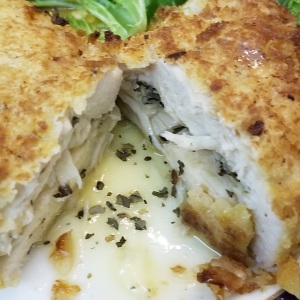
- Big Chicken Breasts (6 halves)
- Butter (140g)
- Shallots (4)
- Bread (4 slices)
- Garlic (3t minced)
- Flour
- Eggs (2)
- Basil
- Mint Leaves
- Salt
- Brown Sugar
- Toothpicks
Preparation
- Begin by brining your chicken breasts overnight, for about 10 hours, in a solution of 3T Salt, 1T Brown Sugar and 4 cups of water. For details you can refer to this post.
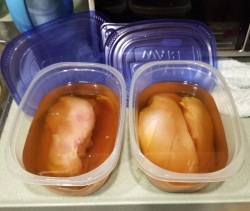
- Place 4 slices of bread exposed in the fridge overnight to dry out.
- When the 10 hours are up, give the chicken breasts a quick rinse to end the brining process and keep them in the fridge until needed.
- Finely chop 4 shallots. Pan fry the shallot bits in 2T of oil on a low flame until you notice a few pieces have turned brown. Turn off the heat and allow to cool. In the meanwhile mince a few garlic cloves until you get 3 semi-heaped teaspoons of garlic.
- Put 140g of butter, that’s about two thirds of a block, in a bowl and cut the butter roughly into cubes. A pair of scissors is the best implement for this. Allow the butter to warm until it is
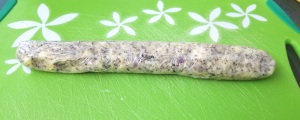 soft, then fold in the minced garlic, shallots, 1T chopped mint and 1T of chopped basil. The butter should stay opaque and not be allowed to melt at any time. Spoon the herb butter onto a large sheet of cling film and roll it into a long rod. Keep the butter sausage in the fridge until it is needed.
soft, then fold in the minced garlic, shallots, 1T chopped mint and 1T of chopped basil. The butter should stay opaque and not be allowed to melt at any time. Spoon the herb butter onto a large sheet of cling film and roll it into a long rod. Keep the butter sausage in the fridge until it is needed.
- Toast the bread under very low heat so it doesn’t brown, until it is dry and crisp. Place the bread into a plastic bag and smash it into crumbs using a mallet.
- The next step is to cut a cavity into each
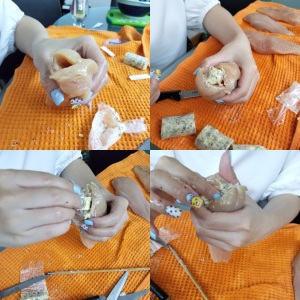 breast. Start by drying the chicken with a tea towel. Plunge a pointed knife about two thirds of the way into a breast from the bigger end. Carefully scrape the tip of the knife along one side of the cavity a few times in a circular motion to enlarge it. Flip the knife over and do the same to the other side of the cavity. While you are doing this, take extra care at all times not to let the knife pierce out through the surface. At the same time you should do your best not to enlarge the opening.
breast. Start by drying the chicken with a tea towel. Plunge a pointed knife about two thirds of the way into a breast from the bigger end. Carefully scrape the tip of the knife along one side of the cavity a few times in a circular motion to enlarge it. Flip the knife over and do the same to the other side of the cavity. While you are doing this, take extra care at all times not to let the knife pierce out through the surface. At the same time you should do your best not to enlarge the opening.
- Cut the butter sausage into six cylinders. Do this while it is still in the cling film. Unwrap one cylinder of butter, halve it lengthwise and push both pieces into the cavity one after another, as far as they’ll go. Repeat the same procedure for the remaining breasts.
- Beat two eggs. Cut a one inch piece off the tip off each chicken breast. Dip these trimmings in the egg and after folding or rolling each piece, use them to plug up the openings. Secure each plug with a wooden toothpick. If you inadvertently punctured any of the breasts earlier, you can attempt to ‘repair’ the damage with toothpicks as well.
- Coat each breast in flour, taking care to cover every part of the breast, especially the area around the plug.
- Heat up a frying pan with some oil. Roll a breast in egg and then the breadcrumbs until it is nicely coated.
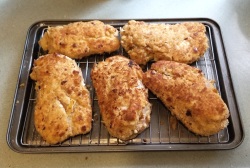 Put the breast straight into frying pan. Pan fry for about a minute, making sure the entire surface is cooked. A pair of kitchen tongs will be helpful in achieving this. Control the fire to make sure the bread doesn’t get burnt. Leave the breast to rest on a wire tray inside a baking tray. Do the same for the remaining breasts, adding more oil to the pan for each new breast.
Put the breast straight into frying pan. Pan fry for about a minute, making sure the entire surface is cooked. A pair of kitchen tongs will be helpful in achieving this. Control the fire to make sure the bread doesn’t get burnt. Leave the breast to rest on a wire tray inside a baking tray. Do the same for the remaining breasts, adding more oil to the pan for each new breast.
- Preheat your oven to 175oC (350oF). Place the tray of chicken into the hot over for 20 minutes, or until you notice the chicken begin to shrink.
- It’s best to serve the Chicken Kiev straight out of the oven. Sprinkle lightly with white pepper while the chicken is still on the baking tray. Remember to remove the toothpicks after plating.
Notes 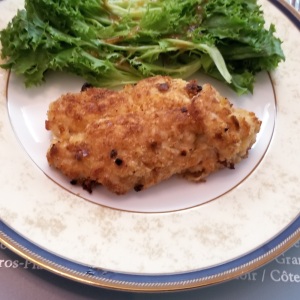
- Purists will no doubt point out that the proper way to make Chicken Kiev would be to pulverize a butterflied chicken breast into a very thin schnitzel which is then rolled around a slab of butter. This method has its merits but is quite labour intensive. Should you ever choose to try it, you should season the chicken instead of brining it.
- Chicken breasts can be plump and roundish or elongated and you should buy the former. I find those from Denmark and Holland are very suitable for stuffing. If the breast is of the elongated type, it will be too flat, making the carving a proper cavity for the butter doubly difficult.
- Don’t expect a large amount of melted butter to gush out when you cut the chicken as some of the butter will be infused into the surrounding meat. If you desire more flowing butter, you can increase the amount of butter to a full block. But in order to do this the cavity has to large; maybe you can wait until you have had some practice at cutting cavities into chicken breast before attempting to use more butter.
- There is no ‘standard’ herb to use for the butter. You can substitute other herbs of your liking, or even add things like sautéed mushrooms to the butter. I even used a bacon onion dip once instead of butter and it tasted great.
- If you have a large number of diners, it may be easier to just deep fry your Chicken Kiev in one go instead.
Tags: Butter, Chicken, French Cuisine, Garlic, Herbs, Russian Cuisine, Shallots
(serves 4, or more depending on size of bird)
Spatchcock is a fancy word for butterflying the whole chicken. It sounds hard, but its quite the opposite. There are many advantages to spatchcocking. First and foremost a flattened chicken roasts more evenly, resolving a major issue with roasting chickens for those without a rotisserie; the thighs take longer to cook than the breast, but ironically when you roast a whole bird it is the breast that is more exposed to heat. Spatchcocking exposes the legs more and brings the breast down, saving the day. In addition, a spatchcocked chicken cooks in half the time and is in a more convenient shape for fitting on a fridge shelf.
Ingredients
- Chicken, whole (1)
- Onion (1)
- Potatoes (2)
- Yam (1)
- Carrot (1)
- Salt
- Brown Sugar
- Butter
- Rosemary
- Fennel Seeds
Preparation Part I
- You have to begin preparation the night before.
- Starting on either side of the bishop’s nose, cut towards the corresponding side of the chicken’s neck (as per the picture below). This is best accomplished using a pair of kitchen shears. You will need to cut through the ribs, but not to worry, these are pretty flimsy in a chicken.
- From the inside of the chicken, snip an incision along the cartilage of the breast bone (it is white) top to bottom to weaken it. Be careful not to pierce the skin on the other side.
- Flip the bird over and press down on the breast with both hands to flatten it. You should end up with the iconic cartoon heart shape chicken breast.
- Prepare a brining solution using 1T salt, 1t brown sugar for every two cups of water. Make enough brine to ensure the entire chicken is submerged. Brine the chicken for 8 hours. If the weather is warm, either add a some ice every once in a while or leave the brining bird in the fridge.
Preparation Part II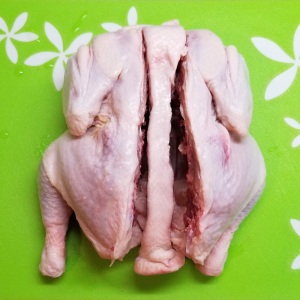
- When the brining is done (presumably the next day), place the bird on a wire tray to dry (as shown below). This will take several hours and again is best done in the fridge. Alternatively you can use a portable fan.
- You must dry the bird properly for it is the key prerequisite to a properly roasted chicken. The chicken is considered sufficiently dry when you put a piece of kitchen towel on it and the paper remains dry but sticks to the skin like a second skin.
- In a small pan, heat 1 heaped t of dried rosemary, 1 heaped t of fennel seeds in 4T of oil until you can smell a strong aroma. Turn off the heat before the herbs get burnt. Leave the pan on the stove while the chicken is drying; more herb flavour will be infused into the oil.
Preparation Part III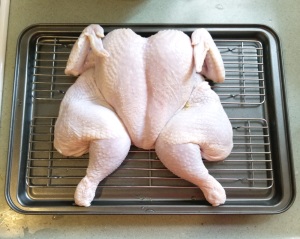
- Cut the potatoes and the yam into chunks. Depending on the variety you may want to peel them first. The yams should be double the size of the potatoes as they cook faster.
- Cut the carrot into discs and the onion into small wedges. Place all the vegetables on a baking tray.
- Preheat the oven to 205oC (400oF).
- Reheat the infused oil. When the oil becomes less viscous, strain the oil into a container. Add a large knob of butter to the oil. Next dissolve half a t of salt in the butter-oil mixture. Drizzle half of this mixture over the vegetables using a spoon.
- Position the chicken over the vegetables on the tray. Make sure all the vegetables end up under the chicken as any piece left exposed will become burnt beyond recognition.
- Paint the remainder of the oil-butter mixture on the chicken with a brush.
- Place the chicken in the oven for 45 minutes, 50 minutes if it is a bigger bird.
- When the chicken is golden brown, remove the pan from the oven without turning it off. Place the chicken on a large serving plate to rest after giving it a light dusting of pepper.
- Roll the vegetables about in the tray to cover them with drippings, space them evenly and place the tray back in the oven for around 10 minutes. When the vegetables have caramelized sufficiently, arrange them around the chicken on the plate. Pour any remaining drippings over the chicken and serve.
Notes
- As you can see from the pictures, the legs were open at an angle while drying but became parallel to each other after cooking as the meat contracted. Purists will secure the chicken with 2 long metal skewers in an X pattern, from the left thigh through to the right breast and vice versa to keep the chicken completely flat. This also helps all the skin brown more evenly. I think its a bit of an overkill, but skewers are definitely a good idea when BBQing.
- My brining mixture is a relatively weak one as we are brining the whole chicken and not just the breast. If you like your roast chicken on the salty side, you can double the salt in the butter-oil mixture to a full teaspoon.
- The back and spine that is cut out is good for boiling stock. If you don’t need it concurrently, you can wrap it in cling film and freeze if for later.
Tags: Brine, Butter, Carrots, Chicken, Onion, potato, Rosemary
(makes 2 dozen wings)
Chicken wings are a party staple and a favourite among children, and the unique blend of Miso and honey will make your wings all the more popular. I have yet to meet a person who didn’t like my Miso-cured wings. The vast majority of Miso-flavoured wing recipes make you cook the wings twice, the second time after painting on a miso glaze. My method does away with this troublesome glazing procedure and cooks the wings in one go. Furthermore, curing allows the flavour of miso to penetrates all the way into the meat.
Ingredients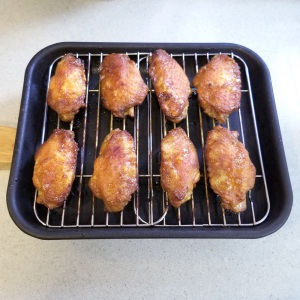
- Mid-joint Chicken Wings (1 kilo)
- Red Miso
- Mirin
- Honey
- Turmeric
- Tahini
- Sesame Oil
- Soya Sauce
- Liquid Smoke (optional)
If you are unfamiliar with Miso, refer to this page. Similarly for information on Mirin, refer to this page.
Preparation
- You need to begin the day before. Defrost and rinse your wings.
- Leave the wings to drain in a colander or strainer for at least 5 minutes.
- Arrange the wings on half of a large dish cloth. Fold the empty portion over and press down gently to dry the wings as best you can. Unfold and allow the chicken to dry further while you make the marinade. You can place a sheet of paper towel between the chicken and the cloth to make the cloth easier to wash, but don’t try using paper towels alone or you end up using half a roll.
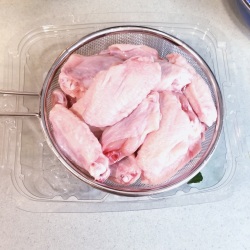
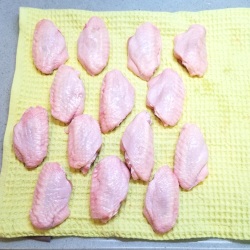
- In a ceramic bowl mix the following: 2T red miso, 2T honey, 1T mirin, 1T tahini, 1T sesame oil, 1t soya sauce and 1t turmeric. You can also add 1t of liquid smoke if that is your preference. (nb. the T’s for the pastes are heaped ones)
- As many of these ingredients are from the fridge you will need to microwave the mixture for about 15 seconds before they will can mix well. Alternatively, put the bowl in a larger bowl of hot water for a while. Stir and mash down with the bottom of a table spoon until all the lumps are gone and you end up with a smooth paste.
- Place the wings in a gallon zip lock and add the marinade. Squeeze out most of the air and then massage the bag and roll it around to get the marinade evenly over all the wings.
- Place the bag flat in the fridge overnight. Some water will be drawn out from the wings making the marinade a bit more watery, that is normal. Flip the bag over once every 6 hours or so to ensure the curing is even.
- The next day the wings will be cured. Arrange them on a wire rack in a tray(s) and allow the wings to warm to room temperature. The wings should not be touching each other. Don’t leave any splotches of marinade on the wings as these will become black patches of burnt skin as the excess sugar carbonizes in the oven.
- Preheat your oven to 180oC (350oF). Place the tray(s) in the oven for 20 minutes. The time may vary a bit from oven to oven, so decide when the wings are ready by visual inspection.
Notes
- The issue with most marinades is they are too watery and they drip off when they heat up in the oven, hence the need to paint on a layer of glaze at the end. That’s why this recipe emphasizes keeping the wings dry, so do not skip steps for 2 and 3. The tahini and turmeric play an important role in keeping the marinade thick so do not substitute them for something else. Also do not add any additional liquid to the marinade.
- You can also use a toaster oven. Set it to 200oC (390oF) and bake each batch for 25 minutes – the toaster oven is weaker than a regular oven, but can do the job – 8 wings at a time as shown in the photo.
- You can also skewer the wings and cook them over a BBQ.
- You can also use white miso, but you will need 3T instead of 2T as it is less salty. The white miso version is milder and sweeter. I typically use 2T white and 1T red when I make my wings.
Tags: BBQ, Chicken, Mirin, Miso, Sesame, Toaster Oven, Turmeric
(serves 8)
The combination of the intense savoury flavour and crunchy explosion of caviar just can’t be beat, but caviar can be a tad salty. In this recipe, this saltiness is perfectly balanced by the mild taste of egg salad to make the perfect amuse-bouche. There are just 5 simple ingredients, making this little package of tastiness incredibly easy to make. You can easily scale it up to serve several dozen guests if you need a dazzling canapé for a party.
Ingredients
- Caviar (1 bottle, 80g)
- Eggs (4)
- Shallots (1)
- Brioche (8 mini slices)
- Mayonnaise
Preparation
- Hard boil 4 eggs (i.e. 12 minutes or more). Allow the eggs to cool in cold water and then de-shell them. You can boil the eggs anytime before and keep them in the fridge.
- Put the each egg through a wire egg slicer three times. On the first pass, slice the egg as per normal but hold on to the ends of the eggs to keep the egg together.
- On the second pass slice the eggs lengthwise. It will be harder to keep the eggs together so do the slicing carefully.

- For the third pass you also slice the egg lengthwise but after rotating them 90 degrees. Hold the slicer over a large bowl to catch the falling bits as the egg will basically fall apart after you are done. The idea is to end up with little cubes of egg white. The yolk will disintegrate but that’s fine.
- Finely (and I mean finely) dice one shallot. You can use a quarter of an onion if you don’t have shallots.
- Add 2 heaped T of mayonnaise, the diced shallot, 0.5t sugar and a generous sprinkle of pepper to the diced egg and mix until the yolk has melted into the mayonnaise.
- Add half the caviar to the egg salad and mix some more. Place the bowl into the fridge for about an hour.
- Divide the caviar egg mixture onto the brioche. The brioche can be lightly toasted, or left untoasted if fresh.
- Decorate each amuse-bouche with the remaining caviar and serve while cold.
Notes
- Caviar is not as expensive a delicacy as you might think, all you need to do is use a caviar made from a fish other than sturgeon. The cheaper varieties taste perfectly fine and in any case you might not want to use top grade caviar as a flavouring ingredient. The bottle I used (pictured right) was made from herring roe and has a retail price of under ten dollars, as will many other varieties.
- Besides brioche you can use any number of other things as the base. Be it a pastry or bread, just make sure it is not of the salty type. The Blini (essentially a mini pancake, second photo) or a Yorkshire Pudding are some alternatives.
- The amount of caviar you reserve for decoration will determine the colour of your amuse bouche. If you mix the whole bottle of caviar in you will get a darker look as per the Blini photo.
- For some colour you can add some chopped chives. The stark green specks will make the amuse-bouche look even more attractive. I really should have done that for the photo.
- In case you were wondering, no that is not a giant ball of caviar in the top photo. It’s an optical illusion. It looks like a large slice of bread on a regular plate but its actually a slice of a mini brioche loaf on a small plate.

Tags: Amuse-bouche, bread, Brioche, Caviar, Eggs, Mayonnaise
(serves 6)
On a whim I decided to combine two of my favourite Chicken and Rice recipes, Chicken and Porcini Risotto and Chicken A La King. It turned out to be yet another match made in culinary heaven. The rich nutty flavour of porcini goes very well with the special brand of sweetness that comes with capsicum. The recipe also uses brined chicken breast to keep the chicken extra tender and separate from the rice.
Ingredients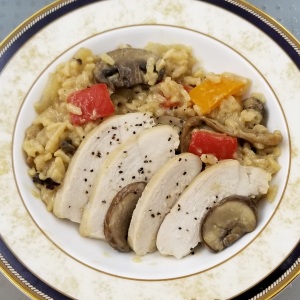
- Dried Porcini Mushrooms (30g)
- Arborio Rice (1.25 cups)
- Brown Mushrooms (150g)
- Chicken Wings (4)
- Chicken Breasts (2 halves)
- Capsicum a.k.a. Bell Pepper (2)
- Onion (1)
- Garlic (1T minced)
- Butter (50g)
- Grated Parmigianino-Reggiano (1/2 cup)
- Cream Cheese
- Rosemary
Early Preparation
- Brine and poach chicken breasts as per the procedure given in this post. You can do this ahead of time and then warm up the chicken breasts in the hot stock before slicing them.
- Simmer 4 chicken wings in 4 cups of water with half an onion and 1t salt. Continue simmering until the meat is practically falling off the bone, adding water is necessary. You can also use 8 mid joints. Start making the stock at the same time you begin the brining.
- You also need to soak your porcini in 2 cups of water. Use cold water, as hot water will give the porcini a slight rubbery texture after it rehydrates. Keep in the fridge.
Preparation
- Bring your chicken stock to a slow simmer. Add the juices from the poached chicken breast and the porcini water (but not the porcini itself) to the stock pot.
- Cut the capsicums in half and remove the stem, core and seeds. Cut the tops and bottoms off and add them into the stock. Cut the sides into 1/4 inch squares and set them aside.
- Cut the brown mushroom into thick slices.
- Mince the garlic and julienne the remaining half of the onion into1/8 inch pieces. In a large pan, fry the onion bits on low heat in 2T of oil until they become yellow and limp. Add the garlic and continue pan frying for a minute.
- Turn up the heat on the pan and add the rice into the pan, stirring well.
- After another minute, add a ladle of stock (liquid only) to the pan and reduce the heat to produce a low simmer. Add the capsicum pieces to the pan at this stage.
- Stir until the risotto begins to dry, then add another ladle of the hot chicken stock. Stir frequently to prevent sticking. The stock pot must be kept simmering to avoid shocking the rice. Continue doing this for about 20 minutes.
- In the meanwhile grate the Parmigianino finely. Cut ¼ of a block of butter into 1 cm cubes and mix it with the grated cheese. Allow the butter to soften out in the open. This forms the mantecatura.
- Dissolve 1T of cream cheese in the last ladle of hot stock before adding it to the pan. Add both the brown mushrooms and the porcini at this stage.
- When your risotto is al dente you can let it almost dry up, after which you turn off the heat. Total simmering time varies a bit with the type of grain you are using, so rely on taste and appearance to decide if the risotto is done and not a timer.
- Stir in the mantecatura and let the risotto rest with the cover on for five minutes. Slice the Chicken breasts.
- After tasting, you may add a bit of salt or more grated cheese to the risotto as a final adjustment if you deem necessary. Arrange the sliced chicken over your plated risotto. Garnish with black pepper.
Notes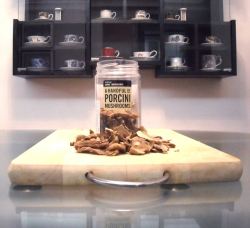
- My first risotto recipe contains many of the finer points on making risotto, which I have opted not to repeat here. You should refer to that post if you don’ make risotto often.
- Capsicums comes in 4 different colours which have different tastes. Red is sweet and easiest on the taste buds, Green is an acquired taste as it is less ripe and bitter. Orange and yellow capsicums are in between the two. I would recommend you use red and orange for this dish.
- For reference these are my Chicken A La King and Porcini and Chicken Risotto recipes.
Tags: Capsicum, Chicken, Italian Cuisine, Mushroom, Parmigiano-Reggiano, Porcini, Recipe, Rice, Risotto
(serves 3)
Chicken A La King is simple conceptually, but it is one of the most difficult dishes to perfect. My mom taught me how to make this the standard way when I was young and over the decades I’ve developed my own improved method of preparing Chicken A La King, one that has superior flavour and at the same time avoids all your typical A La King problems (see notes). I have yet to taste a better version in any restaurants I’ve tried – something I can’t say about any of my other recipes.
Ingredients 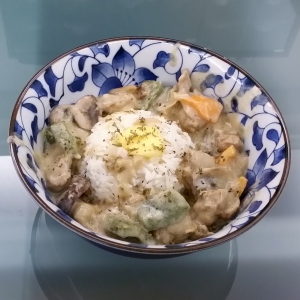
- Chicken Legs with Thigh (2)
- Capsicum a.k.a. Bell Pepper (1)
- Brown Mushrooms (150g)
- Leek (1)
- Milk (1 cup)
- Butter (100g)
- Flour (3T)
- Anchovy in Oil (10g)
- Chicken Stock Cube (1/2)
- Cream Cheese (1T)
- Worcestershire Sauce
- Sherry
- Coriander Seed Powder
- Cooked Rice (4 cups)
Preparation
- Pour 1 cup of milk in a cup and spoon 1T of crea
 m cheese into a bowl, to let them warm up.
m cheese into a bowl, to let them warm up.
- Fry 2 slivers of anchovy in its oil in a pot until you can mash the anchovy into a fine suspension. Add 3 cups of water and half a chicken cube and bring to a low simmer.
- Cut the leek in two and put the top (green) part into the stock pot. Slice the bottom portion lengthwise into half, then cut into 1/8 inch thick half rings. Cut the mushroom into 1/4 inch thick slices. Cut the capsicum into 1/2 inch squares; making sure you discard all the seeds and white pulp.
- Debone the chicken legs and add the bones to the stock pot. Cut the meat into bite sized chunks – its more important that the pieces of chicken are of the same thickness than of the same volume. Place any excess flaps of skin into the stock pot.
- Mix 1T of oil, 1T Worcestershire sauce, 1t coriander seed powder, 0.5t salt in a large bowl. Put the chicken chunks into the bowl and mix well.
- Stir fry the leek pieces in a large pan with some oil on low heat until they begin to go limp. Turn up the fire and push the leek to one side of the pan.
- Add the chicken when the pan is really hot and stir fry until no visible part of the chicken is raw. Then combine with the leek and continue to stir fry until the chicken is cooked (i.e. shrunk a bit like the first photo). Move the chicken to a temp container.
- Melt 70g (1/3 of a standard block) of butter in the same pan on low heat. Spoon in 3T of flour and stir fry until the flour begins to darken. Very slowly add the cup of milk a bit at a time while stirring continuously with a flat spatula to combine all three ingredients. When all the milk is used up, continue the process by adding the hot chicken stock instead. Finally, stir the cream cheese into the sauce. When you are done you should have a smooth velvety white sauce.
- Add the diced capsicum to the sauce and continue to simmer, until the capsicum is no longer rigid. This will take a while, perhaps 10 minutes, add hot water as needed. Next add the mushrooms and 1T of sherry. When the mushrooms begin to shrink, add the chicken and simmer for 1 more minute. Sprinkle on black pepper and taste the sauce to see if salt is required.
- Serve with steamed white rice, topped with a knob of butter.
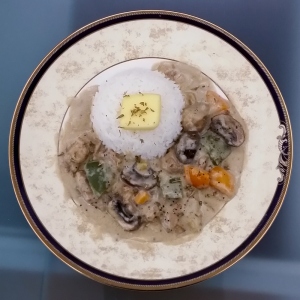
Notes
- Capsicums comes in 4 different colours which have different tastes. Red is sweet and easiest on the taste buds, Green is an acquired taste as it is less ripe and bitter. Orange and yellow capsicums are in between the two. A mixture of two types would be visually pleasing if you are cooking a double portion.
- If you are using chicken breasts instead of legs, you should brine them first. There will be no need to marinate the brined chicken pieces as they are already salty.
- Chicken A La King is supposed to be served with steamed white rice. If you don’t have rice, the other permissible option for Chicken A La King is puff pastry cups (a.k.a. vol au vent). I am against serving it with bread or pasta as some websites show.
- How is my recipe different from the commonly used ones?
- 1. Cooking the chicken separately under a high heat will remove any freezer taste.
- 2. Using chicken stock enhanced with anchovy brings out the flavour of chicken in the white sauce.
- 3. The extended cooking time for the sauce removes any residual taste of flour and fully infuses the sauce with the taste of the capsicum.
Tags: Anchovy, Butter, Capsicum, Chicken, Milk, Mushroom, Rice
 Ingredients
Ingredients 



 you can refer to the ingredients listed on the package of curry powder on the right. Curry powder is the base for making curries. It is not the same as Garam Masala, which is just a seasoning.
you can refer to the ingredients listed on the package of curry powder on the right. Curry powder is the base for making curries. It is not the same as Garam Masala, which is just a seasoning.

























